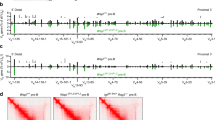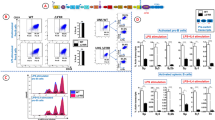Abstract
In general, heterozygous animal cells express both alleles at a particular locus. The only exceptions are cells of XX genotype after inactivation of one X chromosome1, and immunoglobulin-producing cells; in each case only one of the two alleles is expressed in differentiated cells and their progeny2. This phenomenon, termed allelic exclusion, has been described for several mammalian species including man and mouse. It has been shown that the variable (V) and constant (C) region genes of immunoglobulins undergo a rearrangement during ontogeny3,4. We wished to test whether allelic exclusion in B cells could be the consequence of V- and C-region rearrangement on one of the two homologous chromosomes only. For that reason we chose to analyse the rearrangement of immunoglobulin light chain genes in normal B lymphocytes isolated on the fluorescence-activated cell sorter. We now present evidence that during normal B-lymphocyte differentiation V–C rearrangement occurs only on one chromosome.
This is a preview of subscription content, access via your institution
Access options
Subscribe to this journal
Receive 51 print issues and online access
$199.00 per year
only $3.90 per issue
Buy this article
- Purchase on Springer Link
- Instant access to full article PDF
Prices may be subject to local taxes which are calculated during checkout
Similar content being viewed by others
References
Lyon, M. F. Biol. Rev. 47, 1 (1972).
Pernis, B., Chiappino, G., Kelus, A. S. & Gell, P. E. H. J. exp. Med. 122, 853–876 (1965).
Hozumi, N. & Tonegawa, S. Proc. natn. Acad. Sci. U.S.A. 73, 3628–3632 (1976).
Rabbits, T. H. & Forster, A. Cell 13, 319–327 (1978).
Seidman, J. G. & Leder, P. Nature 276, 790–795 (1978).
Joho, R., Weissman, I. L., Early, P., Cole, J. & Hood, L. Proc. natn Acad. Sci. U.S.A. (in the press).
Max, E. E., Seidman, J. G. & Leder, P. Proc. natn. Acad. Sci. U.S.A. 76, 3450–3454 (1979).
Sakano, H., Hüppi, K., Heinrich, G. & Tonegawa, S. Nature 280, 288–294 (1979).
Lenhard-Schuller, R., Hohn, B., Brack, C., Kirama, M. & Tonegawa, S. Proc. natn. Acad. Sci. U.S.A. 75, 4709–4713 (1978).
Loken, M. L. & Herzenberg, L. A. Ann. N. Y. Acad. Sci. 254, 163 (1975).
Wahl, G. M., Stern, M. & Stark, G. R. Proc. natn. Acad. Sci. U.S.A. 76, 3683–3687 (1979).
Morrow, J. F. et al. Proc. natn. Acad. Sci. U.S.A. 71, 1743–1747 (1974).
Monk, M. in Development in Mammals Vol. 3 (ed. Johnson, M. H.) (North-Holland, Amsterdam, 1978).
Author information
Authors and Affiliations
Rights and permissions
About this article
Cite this article
Joho, R., Weissman, I. V–J joining of immunoglobulin κ genes only occurs on one homologous chromosome. Nature 284, 179–181 (1980). https://doi.org/10.1038/284179a0
Received:
Accepted:
Issue Date:
DOI: https://doi.org/10.1038/284179a0
This article is cited by
-
Locus specific epigenetic modalities of random allelic expression imbalance
Nature Communications (2021)
-
Isotype exclusion and transgene down-regulation in immunoglobulin-λ transgenic mice
Nature (1989)
-
Human immunoglobulin κ light-chain genes are deleted or rearranged in λ-producing B cells
Nature (1981)
-
Aberrant rearrangements contribute significantly to the allelic exclusion of immunoglobulin gene expression
Nature (1981)
-
Identification and nucleotide sequence of a diversity DNA segment (D) of immunoglobulin heavy-chain genes
Nature (1981)
Comments
By submitting a comment you agree to abide by our Terms and Community Guidelines. If you find something abusive or that does not comply with our terms or guidelines please flag it as inappropriate.



